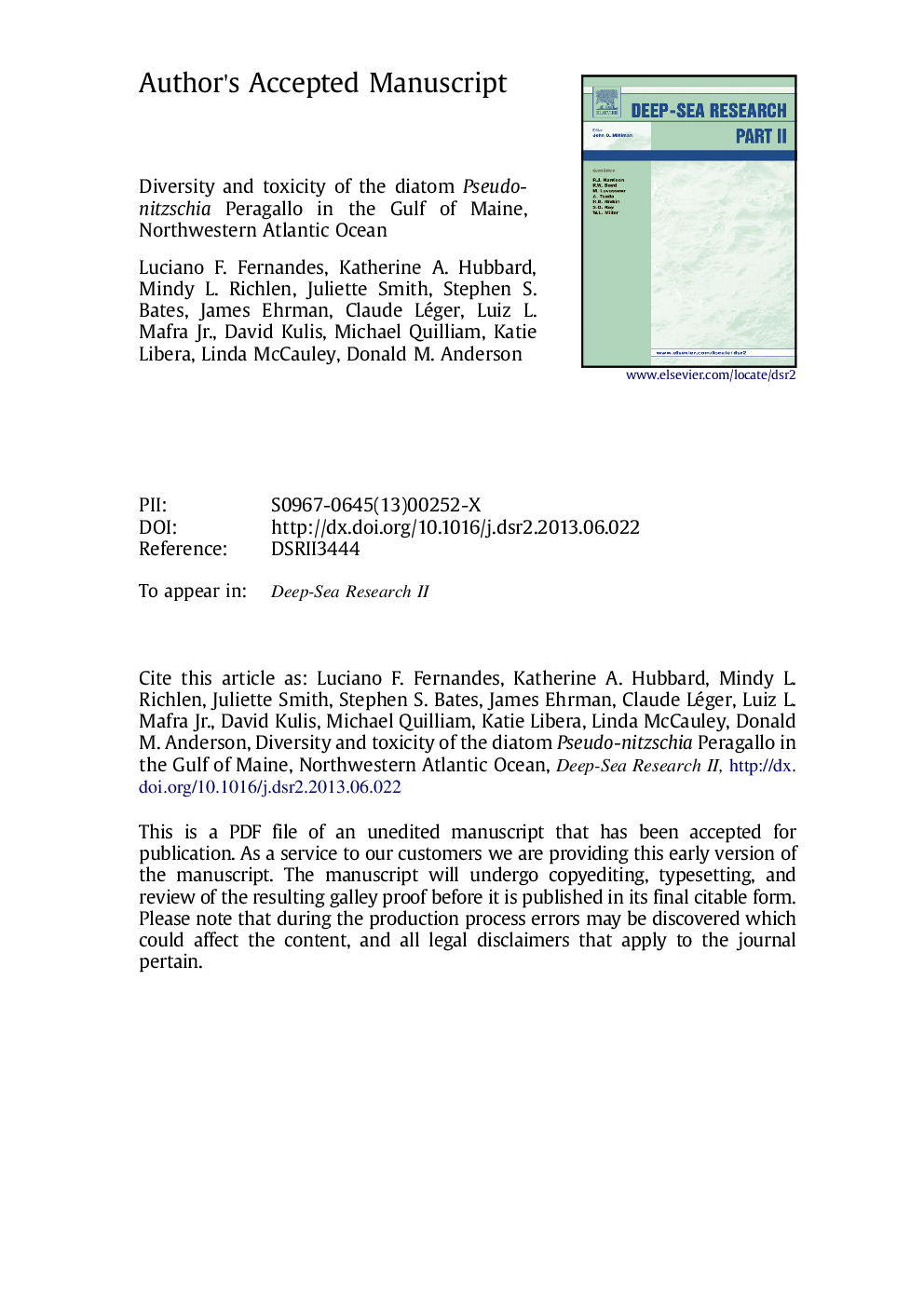| کد مقاله | کد نشریه | سال انتشار | مقاله انگلیسی | نسخه تمام متن |
|---|---|---|---|---|
| 6384222 | 1626437 | 2014 | 79 صفحه PDF | دانلود رایگان |
عنوان انگلیسی مقاله ISI
Diversity and toxicity of the diatom Pseudo-nitzschia Peragallo in the Gulf of Maine, Northwestern Atlantic Ocean
دانلود مقاله + سفارش ترجمه
دانلود مقاله ISI انگلیسی
رایگان برای ایرانیان
کلمات کلیدی
موضوعات مرتبط
مهندسی و علوم پایه
علوم زمین و سیارات
زمین شناسی
پیش نمایش صفحه اول مقاله

چکیده انگلیسی
Multiple species in the toxic marine diatom genus Pseudo-nitzschia have been identified in the Northwestern Atlantic region encompassing the Gulf of Maine (GOM), including the Bay of Fundy (BOF). To gain further knowledge of the taxonomic composition and toxicity of species in this region, Pseudo-nitzschia isolates (n=146) were cultured from samples collected during research cruises that provided broad spatial coverage across the GOM and the southern New England shelf, herein referred to as the GOM region, during 2007-2008. Isolates, and cells in field material collected at 28 stations, were identified using electron microscopy (EM). Eight species (P. americana, P. fraudulenta, P. subpacifica, P. heimii, P. pungens, P. seriata, P. delicatissima and P. turgidula), and a novel form, P. sp. GOM, were identified. Species identity was confirmed by sequencing the large subunit of the ribosomal rDNA (28S) and the internal transcribed spacer 2 (ITS2) for six species (36 isolates). Phylogenetic analyses (including neighbor joining, maximum parsimony, and maximum likelihood estimates and ITS2 secondary structure analysis) and morphometric data supported the placement of P. sp. GOM in a novel clade that includes morphologically and genetically similar isolates from Australia and Spain and is genetically most similar to P. pseudodelicatissima and P. cuspidata. Seven species (46 isolates) were grown in nutrient-replete batch culture and aliquots consisting of cells and growth medium were screened by Biosense ASP ELISA to measure total domoic acid (DA) produced (intracellular+extracellular); P. americana and P. heimii were excluded from all toxin analyses as they did not persist in culture long enough for testing. All 46 isolates screened produced DA in culture and total DA varied among species (e.g., 0.04-320 ng mlâ1 for P. pungens and P. sp. GOM isolates) and among isolates of the same species (e.g., 0.24-320 ng mlâ1 for P. sp. GOM). The 15 most toxic isolates corresponded to P. seriata, P. sp. GOM and P. pungens, and fg DA cellâ1 was determined for whole cultures (cells and medium) using ELISA and liquid chromatography (LC) with fluorescence detection (FLD); for seven isolates, toxin levels were also estimated using LC with mass spectrometry and ultraviolet absorbance detection. P. seriata was the most toxic species (up to 3500 fg cellâ1) and was observed in the GOM region during all cruises (i.e., during the months of April, May, June and October). P. sp. GOM, observed only during September and October 2007, was less toxic (19-380 fg cellâ1) than P. seriata but more toxic than P. pungens var. pungens (0.4 fg cellâ1). Quantitation of DA indicated that concentrations measured by LC and ELISA were positively and significantly correlated; the lower detection limit of the ELISA permitted quantification of toxicity in isolates that were found to be non-toxic with LC methods. The confirmation of at least seven toxic species and the broad spatial and temporal distribution of toxic Pseudo-nitzschia spp. have significant implications for the regional management of nearshore and offshore shellfisheries.
ناشر
Database: Elsevier - ScienceDirect (ساینس دایرکت)
Journal: Deep Sea Research Part II: Topical Studies in Oceanography - Volume 103, May 2014, Pages 139-162
Journal: Deep Sea Research Part II: Topical Studies in Oceanography - Volume 103, May 2014, Pages 139-162
نویسندگان
Luciano F. Fernandes, Katherine A. Hubbard, Mindy L. Richlen, Juliette Smith, Stephen S. Bates, James Ehrman, Claude Léger, Luiz L. Jr., David Kulis, Michael Quilliam, Katie Libera, Linda McCauley, Donald M. Anderson,